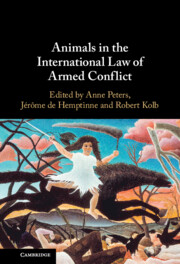Book contents
- Animals in the International Law of Armed Conflict
- Animals in the International Law of Armed Conflict
- Copyright page
- Contents
- Contributors
- Forewords
- Acknowledgements
- Abbreviations
- Part I The Need for Protecting Animals in Wartime
- Part II The Protection of Animals in International and Non-international Armed Conflicts
- 5 Animals as Property and as Objects
- 6 Animals as Specially Protected Objects
- 7 Animals as Part of the Environment
- 8 Animals as Endangered Species
- 9 Animals as War Weapons
- 10 Animals as Combatants and as Prisoners of War?
- 11 Animals as Means of Medical Transportation, Search and Rescue
- 12 Veterinary Personnel
- Part III The Protection of Animals in Specific Situations
- Part IV Enforcement Regimes for the Protection of Animals in Wartime
- Part V Towards Better Protection of Animals in Wartime
- Index
- References
9 - Animals as War Weapons
from Part II - The Protection of Animals in International and Non-international Armed Conflicts
Published online by Cambridge University Press: 06 October 2022
- Animals in the International Law of Armed Conflict
- Animals in the International Law of Armed Conflict
- Copyright page
- Contents
- Contributors
- Forewords
- Acknowledgements
- Abbreviations
- Part I The Need for Protecting Animals in Wartime
- Part II The Protection of Animals in International and Non-international Armed Conflicts
- 5 Animals as Property and as Objects
- 6 Animals as Specially Protected Objects
- 7 Animals as Part of the Environment
- 8 Animals as Endangered Species
- 9 Animals as War Weapons
- 10 Animals as Combatants and as Prisoners of War?
- 11 Animals as Means of Medical Transportation, Search and Rescue
- 12 Veterinary Personnel
- Part III The Protection of Animals in Specific Situations
- Part IV Enforcement Regimes for the Protection of Animals in Wartime
- Part V Towards Better Protection of Animals in Wartime
- Index
- References
Summary
This chapter suggests three legal strategies to leverage international humanitarian law for the protection of weaponised animals in armed conflict in the absence of a direct prohibition of animal weapons. Firstly, one could rely on international, regional organisation and domestic law during non-international armed conflict. Secondly, states can be confronted with their obligation to conduct weapons reviews (relating to international armed conflict). Thirdly, states proposing a ban or regulation on lethal autonomous weapons could be encouraged to promote or support comparable action towards weaponised animals. Even all three strategies in combination would not result in a universal prohibition against weaponising animals. The admittedly patchwork outcome(s) would only offer some measure of protection of animals where little currently exists. Additionally, each line of argument has the potential of gaining additional traction, whether as a matter of law, custom or policy, thus increasing the protection of animals.
Keywords
- Type
- Chapter
- Information
- Animals in the International Law of Armed Conflict , pp. 150 - 170Publisher: Cambridge University PressPrint publication year: 2022

